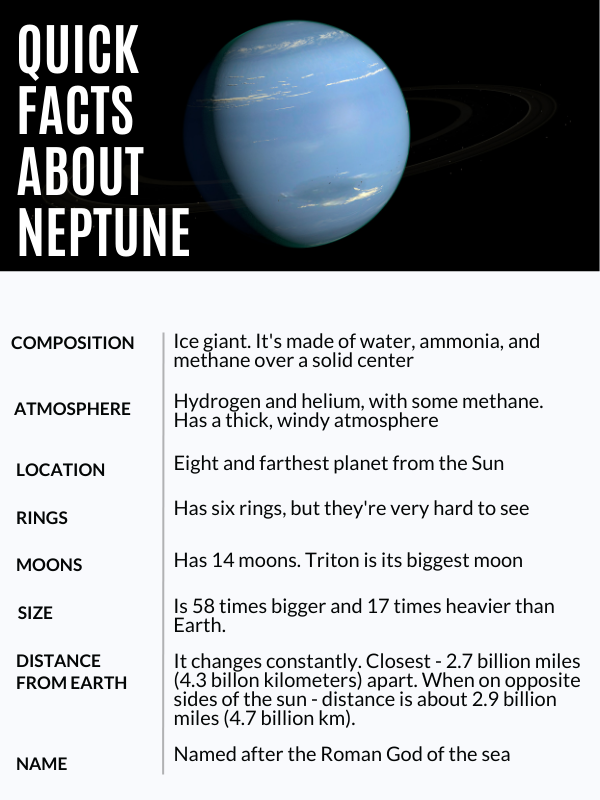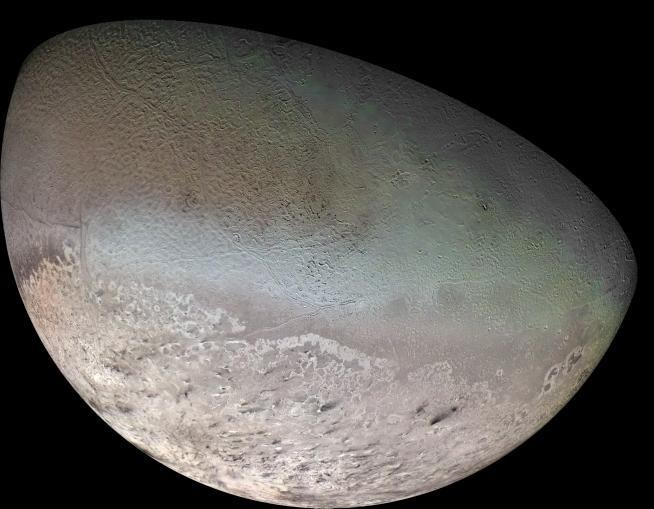Top Amazing Fun Facts About Neptune {Updated 2024}
Written by Manya Pandey, a first-year undergraduate student.
Neptune is named after the Roman god of the sea, as it looks like a big blob of aqua blue ocean against a black backdrop of starry cosmos…
Written by Manya Pandey, a contributing writer
Here we cover all interesting facts about Neptune. You’ll find out who is Neptune named after, what makes Neptune look blue, and many other fun facts about Neptune.
Neptune is the eighth planet from the Sun and is, till now, the farthest solar planet. Its atmosphere is made of hydrogen, helium, and methane.
A quick look at Neptune
Here’s a quick look at all about Neptune.

Did you know – Neptune is 17 times the mass of Earth.
It’s dark, freezing, and lifeless. Moreover, it’s swirling with supersonic winds that are capable of turning skyscrapers to dust.
The wind speeds on Neptune can reach up to 700 miles per hour – these are more powerful than wind blasts in nuclear explosions. Neptune is way more mysterious than you can ever imagine.
Here are more facts about Neptune – the mysterious planet
Neptune is named after the Roman god of the sea, as it looks like a big blob of the aqua blue ocean against a black backdrop of starry cosmos.
What makes Neptune look so blue?

Neptune has a lot of methane in its atmosphere. Methane is a greenhouse gas that causes global warming because it tends to absorb red and other infrared radiations. So when sunlight hits Neptune, all the colours are absorbed except blue, violet and indigo. That’s why the planet appears so blue to our eyes.
What is Neptune made of?
Neptune is an ice giant, much like the other outer planets, and is just an enormous sphere of gasses. Imagine a thick blanket of water vapours, ammonia, and methane wrapped over a solid Earth-sized core, that is what Neptune essentially is. Its atmosphere is an amalgamation (combination) of gasses like hydrogen, helium, and methane.
Now you know what is Neptune made of!
How many moons does Neptune have?

Neptune has 14 moons that we know of.
We tell you about them a little below. But, here’s what’s interesting about the names of Neptune’s moons – they are all named after sea gods and nymphs from Greek mythology. This is because Neptune was named after the Roman god of the sea!
More information about Neptune
The planet was discovered in 1846 by Urbain Le Verrier and Johann Galle, before which scientists were not even aware of the existence of an 8th planet as it is so far away that we can’t see it without a telescope.

The images shared by NASA, on Twitter, feature Neptune and its rings. They were captured by James Webb Space Telescope. This is by far the clearest view of Neptune’s rings since the Voyager 2 spacecraft flew by it in 1989. It has also captured seven of Neptune’s 14 known moons.
How did scientists find Neptune?
The story
In 1781 Space researchers finally discovered Uranus, Neptune’s lone neighbour. The discovery thrilled all the space minds around the globe and the new planet became a fresh destination for everyone’s telescopes.
But soon after, space observers noticed some anomalies in Uranus’s orbit and the only way to explain these miscalculations was to assume the presence of another 8th planet whose gravity was affecting Uranus’s journey around the sun.
So briefly, in 1845 two astronomers, Urbain Le Verrier and John Couch Adams, began calculating the position of this disturbing planet, independently, and in 1846 Johann Galle used Le Verrier’s calculations to find Neptune, merely 1 degree away from its estimated position.


Now for some fun facts about Neptune.
15 Fun Facts About Neptune for kids

1. Neptune takes 165 Earth years to go around the Sun
Neptune has to travel for a really long time around the sun to complete its one year. The planet completed its first year in 2011, as it was the only time we witnessed the end of a 165-year orbit, since its discovery in 1846.
In fact, Galileo Galilei, the great astronomer, had observed Neptune in 1962 but dismissed it as some random space object because of its slow motion relative to the background stars. Isn’t that one of the most bizarre fun facts about Neptune?
2. Neptune has only been visited once
Only one spacecraft named Voyager 2 has ever visited Neptune. Voyager-2 was on its way out of the solar system when it encountered Neptune in 1989. Currently, Voyager 2 is exploring the most distant parts of our universe, where no spacecraft has ever been.
3. Neptune has 14 moons
Here’s something interesting – all of Neptune’s moons are named after gods in Greek mythology.
Triton is the largest of them all. It was discovered by William Lassell on October 10, 1846. What’s interesting that this discovery was made only 17 days after the discovery of the planet itself.
Here’s something interesting about Triton – it is the only large moon in the solar system that circles its planet in the opposite direction of the planet’s rotation. Some scientists believe that this could mean that Triton may once have been an independent object. It’s very cold – its temperatures are about minus 391 degrees Fahrenheit (which is minus 235 degrees Celsius).
The second moon Nereid was discovered more than a century later.
Proteus, one of the biggest Neptune moons, was discovered in 1989 by the Voyager 2 spacecraft. The strange thing is that this discovery was made so late even though a smaller one – Nereid, was discovered 33 years earlier. The reason is that Proteus is very dark so was missed.
4. Neptune is four times wider than Earth
Neptune has a vast radius of over 24 thousand kilometres, which is roughly 4 times the radius of the Earth. Just to give you an estimate, if the Earth was a golf ball, Neptune would be a basketball.
5. One season on Neptune lasts for 40 years
This might be one of the most mind-boggling fun facts about Neptune but the planet’s axis of rotation is tilted by 28 degrees which means it experiences seasons as we do on Earth (as seasons are nothing but variation in the intensity of sunlight) because Neptune takes over 160 years to revolve around the sun, each of the four seasons lasts for over 40 years.
6. Neptune radiates more heat than it receives
That’s another similarity it shares with other gas giants namely Jupiter and Saturn. This phenomenon suggests Neptune has an immense internal heat source and according to a prevailing theory, this immense internal heat causes air to rise thereby creating vertical convection and supersonic winds. It radiates about twice as much energy as it absorbs from the Sun.
7. Neptune faces mysterious storms that probably smell like rotten eggs
Way back in 1980, Voyager 2 spacecraft observed some dark brown spots on the planet and scientists have estimated that it was probably methane or sulfur gasses swirling in the storm, these gases probably smell like rotten eggs.
The latest storm was first seen in 2015, by NASA’s Hubble telescope and is currently shrinking in size.
8. Sunlight takes 4 hours to travel from the Sun to Neptune
The planet is so far away that sunlight takes multiple hours to reach the surface whereas it only takes 8 minutes to reach Earth. That may not be one of the most thrilling fun facts about Neptune. So let’s continue.
9. Neptune does not have a solid surface
You can’t stand on Neptune because it doesn’t really have a surface! The planet has a rocky core, but it’s mainly just an enormous ball of hydrogen and helium. It’s not alone once again, all four gas giants share a similar fate because all these planets were formed when a solid core pulled in tons of dust and gases , with its gravity.
10. Neptune is the windiest planet in our solar system
Neptune’s winds can be nine times stronger than the Earth’s. Even though the planet receives the least energy from the sun and it is not so hot to stir up such enormous storms, still, these winds can send frozen clouds of methane flying across the planet at speeds of more than 1,000 kilometres per hour. The winds on Earth can only reach up to 400 kilometres per hour.
11. Recently the global temperature of Neptune dropped by 8 degrees Celsius.
The average global temperature on Neptune unexpectedly fluctuated, it’s the first time such a major shift has happened in the last 17 years. The images clicked between 2003 and 2009 reveal that Neptune’s stratosphere has cooled down though the south pole has been warming up, especially between the years 2018 and 2020.
12. Neptune was first predicted through mathematics, way before it was even discovered
It’s the only planet that has had such a fate in our solar system. As you know, Neptune is invisible to the naked eye and too slow for observation. Ancient astronomers might have seen a slow-moving orb in space but dismissed the possibility of such a slow-going planet.
13. Most of its mass is a hot dense fluid
Neptune is the densest planet among all the ice giants. According to NASA
(National Aeronautics and Space Administration ), almost 80 percent of the planet’s entire volume comprises hot dense icy materials and ammonia fumes.
14. One day on Neptune goes by in 16 hours.
The planet moves really slow around the sun(revolution) but it moves quite fast on its axis(rotation) Neptune completes one rotation in just 16 hours, now that’s 8 hours quicker than the Earth.
15. Sometimes Neptune is even farther from us than Pluto is!
Pluto was once our 9th planet but now has been reduced to just a dwarf. Interestingly, Pluto is sometimes closer to the Sun and the Earth than Neptune because it has an elliptical orbit. Isn’t that one of the most unsettling fun facts about Neptune?
Fun facts about Neptune’s moons

Triton, the largest Neptune moon, circles the planet in the opposite direction
Triton is the only giant moon in the solar system that circles in the direction opposite to the rotation of its planet. Simply, if Neptune moves clockwise on its axis, Triton goes anticlockwise around it. This phenomenon suggests Triton was once an independent body that was captured in Neptune’s gravity.
Triton spews out geysers in the space
On the surface, it looks like just another icy moon but underneath its thick frozen covers, Voyager 2 discovered geysers coming out of the planet. They extend up to 8 kilometres from the planet and spew out icy material upwards. Triton also has a thin atmosphere that seems to be getting warmer.
Interesting information about Neptune rings.
Neptune is ornamented by five rings. These rings appear reddish and are made of dust, ice particles, and organic compounds generated by the intense energy of the sun.
The rings of Neptune are believed to be younger and short-lived than the planet which means they might not have formed with the planet 4.5 billion years ago instead the planet acquired them later in its life. Interestingly the rings are named in honour of the astronomers who contributed to the important findings and discovery of the planet namely: Galle, Le Verrier, Lassell, Arago, and Adams. Here are some fun facts about Neptune rings.
Neptune’s ring system has distinct features of dust called “arcs”
The Adams ring has a unique feature called “arcs”. These arcs are nothing but clumps of ring material. The arcs seem absurd because the laws of physics dictate that dust particles tend to spread out instead of staying in clumps but Scientists now believe it’s all related to the gravitational effects of a nearby moon, Galatea.
Why is Neptune an amazing planet?
As you know, Neptune has only been visited by Voyager 2 when it was finding its way out of the solar system. During that brief fly-by, it saw some interesting features including bright cirrus clouds and the “Great Dark Spot”.
Cirrus clouds are white fiber-like clouds you sometimes see in the sky and they’re there on Neptune too. In fact, the voyager spacecraft found one cirrus cloud that went across the planet every 16 hours, this cloud was nicknamed “scooter“.
On Earth, these clouds are made of water vapours but on Neptune, these clouds comprise methane ice crystals.
About the “Great Dark Spot”

“The Great Dark Spot”, a mysterious dark feature on Neptune -was captured by voyagers but it has now disappeared from where it was seen, instead the Hubble telescope reported another dark oval appearance on the planetary surface. Though Neptune is not the only planet with this appearance, Jupiter has what’s called Jupiter’s Great Red Spot.
Scientists believe that Neptune’s “Great Dark Spot” is a hole in the methane cloud floor, much like the ozone hole we have in the Earth’s atmosphere.
More reasons why is Neptune an amazing planet
It might be raining diamonds on Neptune! Scientists have speculated about diamonds on Neptune along with other outer planets for a long time now but they have never seen it. They believe that methane(a chemical gas made of carbon and hydrogen), which is abundant in Neptune’s atmosphere, gets compressed under extreme pressure conditions and storms – and turns into diamonds (diamonds are essentially carbon compressed under intense pressure and temperature). These were some of the most interesting facts about Neptune.
Before we wrap up, did you know that sunlight seems 900 times brighter on Earth than it does on Neptune?
Also Read

I Kid You Not now has a large readership across India and also parts of the world. If you want to write for us, you can submit your story here. You can also apply to become a news anchor. Apply here



Comments